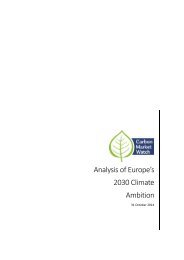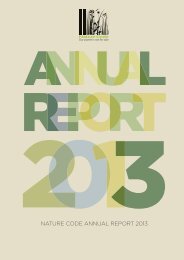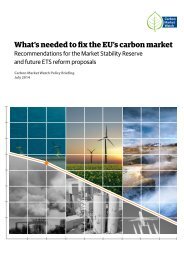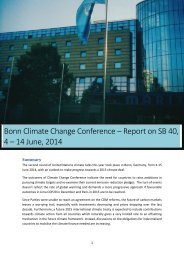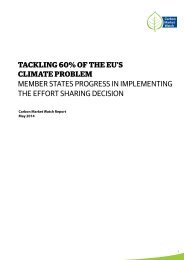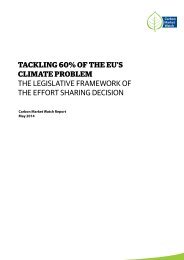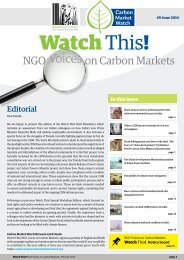Create successful ePaper yourself
Turn your PDF publications into a flip-book with our unique Google optimized e-Paper software.
TRANSPORT<br />
Transport emissions have increased by over one third since 1990<br />
and are the second largest source of EU greenhouse gas emissions<br />
after the power sector. Emissions are projected to decrease by less<br />
than 1% by <strong>2020</strong> from 2005 emissions levels. <strong>The</strong> EU’s objective is<br />
to reduce transport emissions by 20% in 2030 compared to 2008<br />
levels v but this will not happen without further measures.<br />
Existing EU policies that help Member States achieve their ESD<br />
targets include inter alia:<br />
BUILDINGS<br />
Emissions from the building sector have been slowly declining<br />
over the last years, mostly due to energy retrofits in existing<br />
buildings. <strong>The</strong> building sector’s emissions are expected to decline<br />
by 9% from 2005 to <strong>2020</strong>. Around 75% of the projected reductions<br />
under the <strong>Effort</strong> <strong>Sharing</strong> <strong>Decision</strong> are expected to come from<br />
energy efficiency measures in the building sector, vi but the sector<br />
could deliver much higher cost-effective reductions.<br />
Existing EU policies that impact building emissions include inter<br />
alia:<br />
<strong>The</strong> Cars & CO2 Regulation establishes mandatory emission<br />
reduction targets for new cars. <strong>The</strong> fleet average to be achieved<br />
by all new cars is 130 grams of CO2 per kilometre by 2015 and<br />
95g/km by 2021. Currently, cars are responsible for around<br />
12% of EU’s total carbon dioxide emissions.<br />
<strong>The</strong> Fuel Quality Directive requires a reduction of the<br />
GHG intensity of fuels used in vehicles, calculated on a lifecycle<br />
basis, by a minimum 6% by <strong>2020</strong>. <strong>The</strong> policy promotes<br />
cleaner fuels over more carbon-intensive ones and aims to<br />
reduce emissions that result from the extraction, production,<br />
processing and distribution of fuels.<br />
<strong>The</strong> Energy Efficiency Directive includes a set of specific<br />
efficiency measures that Member States and private actors<br />
need to implement to bring the EU closer to achieving its <strong>2020</strong><br />
20% headline target on energy efficiency. Since there are no<br />
binding national energy efficiency targets, the EEA predicts<br />
that the EU will not achieve its headline target. vii<br />
<strong>The</strong> Energy Performance of Buildings Directive establishes<br />
minimum energy performance requirements for new and<br />
existing buildings and mandatory energy certification for all<br />
properties that are constructed, sold or rented out.<br />
AGRICULTURE AND FORESTS<br />
<strong>The</strong> main sources for greenhouse gas emissions from agriculture<br />
are livestock (methane emissions) and fertilizer use (N2O<br />
emissions). Emissions reductions can be achieved by lowering<br />
N2O emissions through improving efficiency of nitrogen fertilizer<br />
use and lower nitrogen input, lowering methane emissions<br />
through improved feed in cattle and through prevention of<br />
emissions from manure storage and application. In contrast, the<br />
LULUCF sector is a net carbon sink and is expected to remain a net<br />
sink until at least 2050.<br />
Currently, the emissions from agriculture are treated in the <strong>Effort</strong><br />
<strong>Sharing</strong> <strong>Decision</strong> while the emissions and removals related to land<br />
use, land use change and forestry (LULUCF)<br />
are excluded from the EU’s <strong>2020</strong> reduction<br />
target. LULUCF should also contribute to<br />
the mitigation efforts necessary to reach<br />
the EU’s climate objectives outside the<br />
scope of the <strong>Effort</strong> <strong>Sharing</strong> <strong>Decision</strong>. LULUCF<br />
emissions and removals are characterised<br />
by potentially large annual fluctuations<br />
and long-time horizons, while there are<br />
uncertainties relating to data reliabilities.<br />
<strong>The</strong>se characteristics make the sector unfit<br />
for inclusion in the <strong>Effort</strong> <strong>Sharing</strong> <strong>Decision</strong> that has an annual<br />
compliance cycle.<br />
A separate LULUCF pillar with adequate national targets gives<br />
an opportunity for a policy approach that reflects the sector’s<br />
particularities like permanence, long time cycles and natural<br />
variability. All LULUCF activities should be included in this pillar;<br />
besides forestry also cropland and grazing land management and<br />
“<strong>The</strong> LULUCF sector<br />
should also contribute<br />
but outside the scope<br />
of the <strong>Effort</strong> <strong>Sharing</strong><br />
<strong>Decision</strong>”<br />
wetland drainage and rewetting. This is necessary to incentivise<br />
mitigation in the whole sector, including addressing emissions<br />
from peat lands. In some Member States the emissions from other<br />
LULUCF activities may even exceed the<br />
removals achieved by the forest activities<br />
by 2030.<br />
A separate mitigation target for the<br />
LULUCF sector at least maintaining the<br />
current carbon sink could also help to<br />
address the missing link between the<br />
energy and land use sector. Currently, the<br />
emissions associated with the removal of<br />
biomass from the ecosystem -including<br />
the change in carbon sink over a certain time frame- are not<br />
accounted for, as in EU’s climate legislation the combustion<br />
of this biomass is wrongly assumed to be “carbon neutral” (i.e.<br />
zero emissions). A mitigation target for the LULUCF sector could<br />
increase the likelihood that bioenergy emissions are not hidden,<br />
but at least until then there should be default emission values for<br />
the combustion of biomass under the ETS and the ESD. Imports<br />
of bio-energy should also not to be counted as carbon neutral.<br />
6





